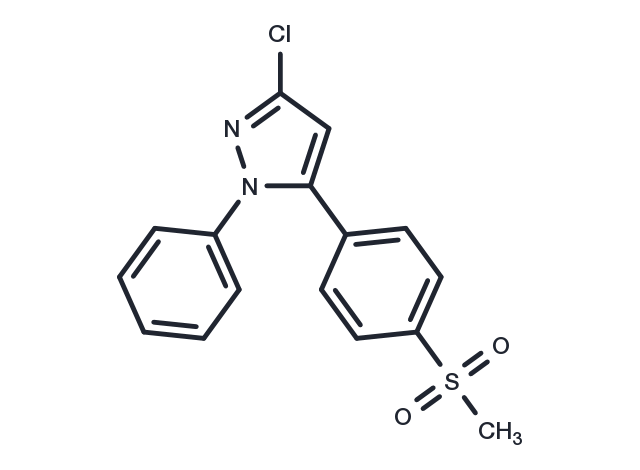Powder: -20°C for 3 years | In solvent: -80°C for 1 year


FR-188582 is a highly selective cyclooxygenase (COX)-2 inhibitor (IC50: 17 nM).

| Pack Size | Availability | Price/USD | Quantity |
|---|---|---|---|
| 25 mg | 6-8 weeks | $ 1,670.00 | |
| 50 mg | 6-8 weeks | $ 2,180.00 | |
| 100 mg | 6-8 weeks | $ 2,800.00 |
| Description | FR-188582 is a highly selective cyclooxygenase (COX)-2 inhibitor (IC50: 17 nM). |
| Targets&IC50 | COX-2:17 nM |
| In vitro | FR-188582 inhibits COX-2 (IC50: 17 nM), in a recombinant human COX enzyme activity. The inhibition of prostaglandin (PG) E2 formation by FR188582 is over 6000 times more selective for COX-2 than COX-1. |
| In vivo | FR-188582 (0.01-3.2 mg/kg, p.o.) reverses paw edema in adjuvant arthritic rats and displays a therapeutic effect in a dose-dependent manner. For adjuvant-injected paws and adjuvant-uninjected paws, the ED50s values (95% C.L.) are 0.074 (0.00021-0.53) and 0.063 (0.0039-0.31) mg/kg , respectively. The anti-inflammatory effect of FR-188582 is threefold more potent than that of Indomethacin. For adjuvant-injected paws and adjuvant-uninjected paws, the ED50s values (95% C.L.) are 0.24 (0.047-1.8) and 0.20 (0.021-0.79) mg/kg, respectively. |
| Molecular Weight | 332.8 |
| Formula | C16H13ClN2O2S |
| CAS No. | 189699-82-9 |
Powder: -20°C for 3 years | In solvent: -80°C for 1 year
You can also refer to dose conversion for different animals. More
bottom
Please see Inhibitor Handling Instructions for more frequently ask questions. Topics include: how to prepare stock solutions, how to store products, and cautions on cell-based assays & animal experiments, etc.
FR-188582 189699-82-9 Immunology/Inflammation Neuroscience COX FR 188582 FR188582 inhibitor inhibit
